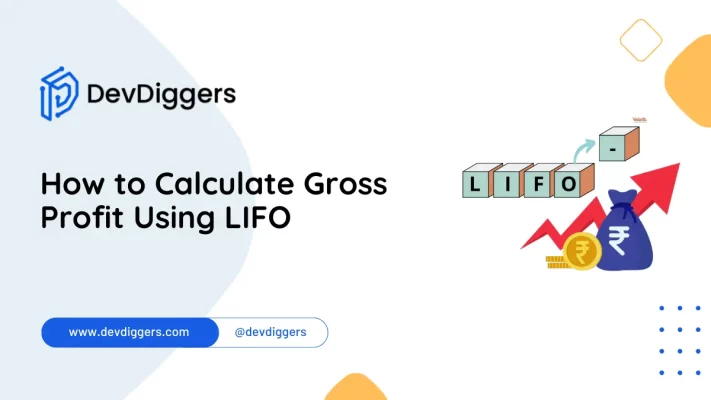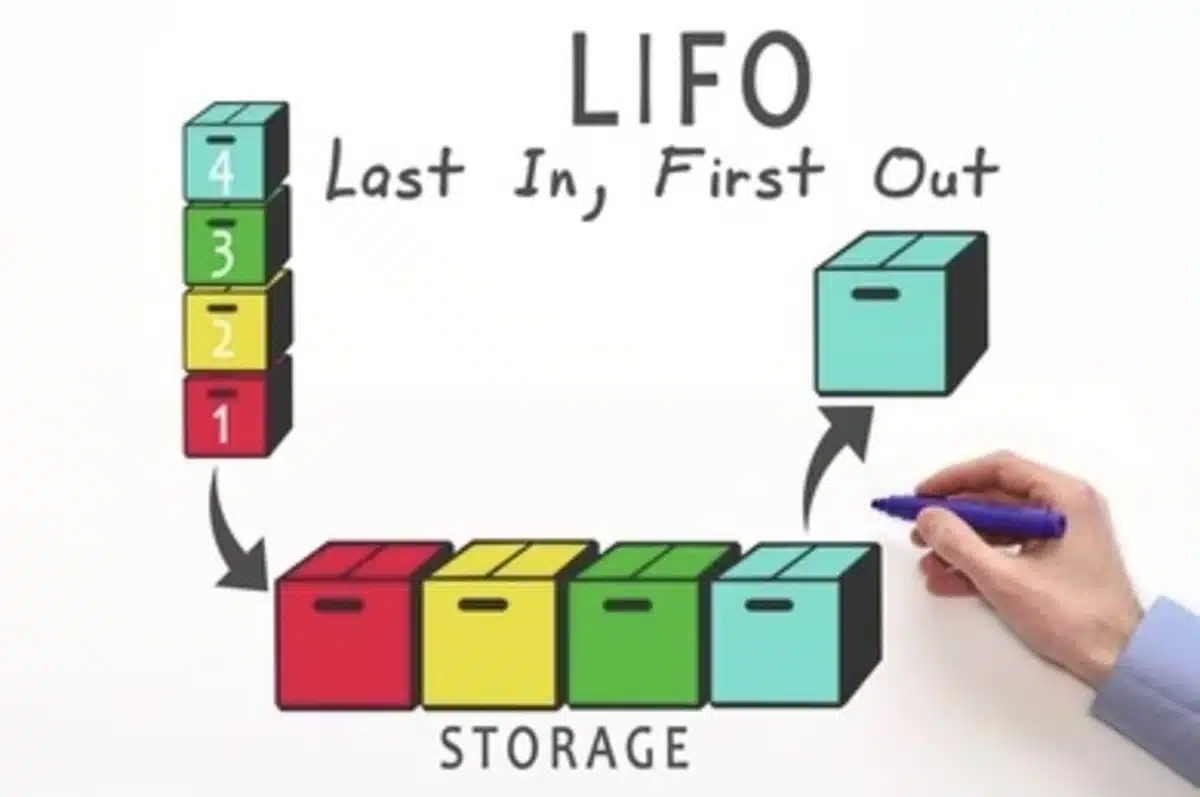How to Calculate Gross Profit Using LIFO

Evaluating the profitability of a firm greatly depends on the approaches taken to determine gross profit, and this applies to LIFO as well.
LIFO inventory costing assumes that the goods purchased most recently are sold first. This has an effect on cost of goods sold (COGS), gross profit and other components related to profitability.
This blog is devoted entirely to epitomize the steps about how to Calculate Gross Profit Using LIFO, its merits and consequences, and comprehensively detailing the steps needed to evaluate financial performance correctly.
What is Gross Profit?

Gross profit is a financial term that measures the difference between a company’s revenue and its cost of goods sold (COGS).
It measures a company’s efficiency in producing and selling its products or services.
The Formula for Gross Profit:
Gross Profit = Revenue - Cost of Goods Sold (COGS)
This metric is crucial for determining a company’s profitability and operational efficiency since it indicates how much money is available to cover operating expenses, taxes, interest, and net profit.
What is LIFO?

Before diving into the calculation of gross profit using the LIFO method, let us first clarify what LIFO means.
LIFO stands for last-in, first-out, which is an inventory costing method and has an impact on the calculation of gross profit.
Under this assumption, the more recently purchased inventories are sold off first and this has implications for COGS and the value of the ending inventory.
LIFO, which stands for last-in, first-out, can help improve the difference between cash flow and income during inflationary periods where the recent inventory costs need to be aligned with sales and thus, lower the taxable income.
Comprehending LIFO is extremely essential to accurately calculate gross profit with this approach as it affects the way expenses are allocated for financial statements and the assessment of company performance.
How to Calculate Gross Profit Using LIFO
Use these instructions to learn how to calculate gross profit using Last-In, First-Out (LIFO):
1. Recognize the Elements
- Sales Revenue: The total amount of money received from selling of goods.
- Cost of Goods Sold (COGS): The price paid for the inventory sold during the given time frame.
- Initial Inventory: The total inventory value at the start of the period.
- Purchases: The price of the inventory that was bought at that time.
- Ending Inventory: The inventory value at the end of the period is known as ending inventory.
2. Determine the COGS Using LIFO
LIFO assumes that the last items purchased are the first to be sold. Here’s how to calculate COGS using LIFO:
Step-by-Step Calculation of COGS:
Step 1: List Purchases Chronologically: Arrange your inventory purchases chronologically, with the most recent purchases at the top.
Step 2: Match Sales with Recent Purchases: To calculate the COGS, match the number of units sold with the costs of the most recent purchases. Continue this process until the total number of units sold is accounted for.
Example Calculation:
Assume you sold 500 items throughout the period and have the following purchase history.
- On January 1, 100 units were bought for $10 each.
- On February 1, 200 units were bought for $12 each.
- On March 1, 300 units were bought for $15 each.
- On April 1, 400 units were bought for $18 each.
To calculate the COGS using LIFO:
The last purchase is April 1: 400 units at $18 = $7,200.
Remaining units needed: 500 – 400 = 100 units.
The next most recent purchase is March 1: 100 units at $15 = $1,500.
Total COGS = $7,200 (from April) + $1,500 (from March) = $8,700.
3. Calculate Gross Profit
To calculate gross profit using LIFO, use the formula:
Gross Profit = Sales Revenue − COGS
Using the example above:
- Assume the total sales revenue for the 500 units sold is $25,000.
- COGS calculated using LIFO is $8,700.
Gross Profit = $25,000−$8,700 = $16,300
How LIFO Affects Gross Profit
In the process of understanding how to calculate gross profit using LIFO. LIFO (Last In, First Out) is an inventory valuation method commonly used in accounting.
Under LIFO, the most recently acquired inventory items are assumed to be the first sold.
This impacts gross profit calculations in different ways:
- Cost of Goods Sold (COGS): In periods of increasing prices, sales will always reflect the higher market prices for the newer inventory purchased, therefore using LIFO means that COGS will be higher than in situations when FIFO or average cost inventory valuation methods are used. This means COGS is greater under LIFO than inventory valuation methods of FIFO or average cost.
- Ending Inventory Valuation: In LIFO, the ending inventory valuation reflects the cost of the oldest inventory items still in stock, because the most recent ones have already been assumed to be sold. Inversion of prices creates lower valuation of ending inventory compared to FIFO. This also results in lower taxable income because COGS increases and gross profit decreases.
- Gross Profit Calculation: Revenue less cost of goods sold gives gross profit. Because LIFO assumes most recently sold inventory is also the most recently acquired (and typically higher priced) item, COGS will be greater than FIFO or average cost methods, hence reducing gross profit.
As noted earlier, LIFO increases the cost of goods sold and reduces the gross profit because it assumes the most recently acquired inventory is sold first when, under other inventory valuation methods, gross profit would have been greater.
Key Points to Consider Before Calculating Gross Profit Using LIFO
Before you start implementing the process of how to calculate gross profit using LIFO method, several vital points need consideration:
- Inventory Valuation: You need to remember that the Last In, First Out (LIFO) approach sells the newest inventory first, and consider its effect on inventory valuation. This approach does not consider the actual cost of goods sold during inflationary periods.
- Impact on Gross Profit: Expenses and revenues for a business are often compared using multiple methods, one example being First-In, First-Out (FIFO) – or weighted average cost, which allows them to achieve a better gross profit. LIFO provides a greater cost burden because it sells the most recent and expensive stock collapse of items first, causing revenue to be higher than profit.
- Financial Reporting: Consider the ramifications for financial reporting. Although LIFO is accepted under GAAP in the U.S, it is banned under IFRS and can limit comparability across peers.
- Tax Considerations: Know about the benefits of using LIFO for tax purposes during times of inflation because, under LIFO, higher pric-ed stock is kept at a reservoir level and is sold first to the expense account thereby decreasing net income and tax income.
- Consistency: Apply the LIFO approach without bias or inconsistency. Changing from LIFO to another inventory costing method may have significant financial consequences that require them to be written in the financial statements.
- LIFO Accounting Disclosures: Note all disclosures associated with using LIFO in the financial statements. This includes the method chosen, results, and possible ramifications of using such a method.
- Industry Practice: Pay attention to norms and practices within the industry pertaining to inventory valuation. Certain segments of the industry may be inclined to adopt LIFO due to tax benefits or industry-wide compliance.
- Purpose of Management Decisions: Examine the purpose behind management’s choice of LIFO and determine whether the intention is consistent with the financial policies of the firm.
Conclusion
In summary, it is evident that calculating gross profit using LIFO is critical for business owners, accountants, and analysts.
This blog enables ease of achieving accuracy by explaining the application of the Last-In, First-Out (LIFO) method of inventory calculation.
Understanding inventory valuation, gross profit margins, financial statements, associated tax liabilities, and how they interrelate with the LIFO method is significant.
Along the same lines, we can calculate gross profit by using the FIFO method, one of the algorithms set forth above, through LILO.
FAQs
Q.1 Why is LIFO used for inventory valuation?
LIFO matches the cost of goods sold with the current revenue, providing a more accurate representation of profitability, especially during inflation when inventory costs are rising.
Q.2 Can LIFO be used for any inventory?
While LIFO can be used for various types of inventory, it’s most effective for products with a short shelf life or those subject to frequent price changes.
Q.3 Are there any disadvantages to using LIFO?
One disadvantage of LIFO is that it may not accurately reflect the actual cost of inventory on hand, especially during periods of inflation, as it values inventory at older, lower costs.
Q.4 Is LIFO permitted under Generally Accepted Accounting Principles (GAAP)?
Yes, LIFO is an accepted method under GAAP, but its use in financial statements must be disclosed due to its potential impact on inventory valuation and profitability.
Q.5 How does LIFO differ from FIFO (First In, First Out)?
Unlike FIFO, which assumes the oldest inventory is sold first, LIFO assumes the newest inventory is sold first. This can lead to different inventory valuations and profit calculations.

Kartika Musle
A Tech enthusiast and skilled wordsmith. Explore the digital world with insightful content and unlock the latest in tech through my vision.

Leave a Reply